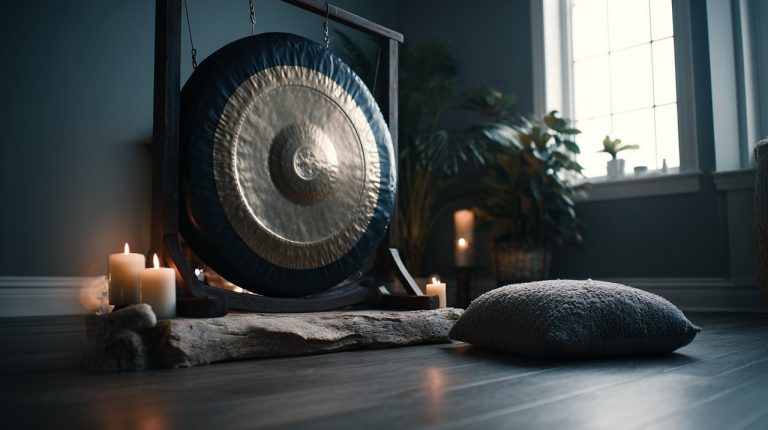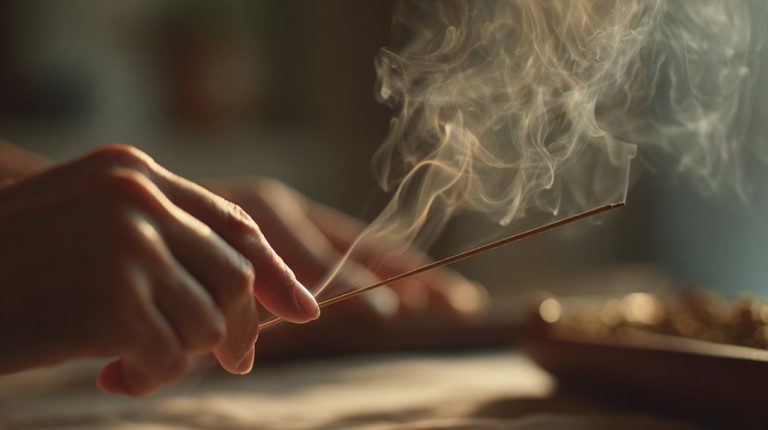What Is Thangka Art? A Gateway To Spiritual Practice
In our modern quest for deeper meaning and inner tranquility, certain ancient traditions offer remarkably insightful paths to spiritual connection. While Thangka art provides a unique visual journey, other practices like exploring chakra balancing techniques also offer avenues for cultivating inner harmony and well-being, complementing the rich tapestry of spiritual exploration. Among these, Thangka art stands out not merely as a beautiful painting, but as a vibrant, living portal to Buddhist philosophy and a rigorous spiritual discipline. Each Thangka, meticulously crafted over months or even years by devoted master artists, is a testament to unwavering dedication, sacred geometry, and precise iconography. This extraordinary commitment elevates Thangka beyond a simple art form, transforming it into a consecrated object designed to facilitate deep spiritual engagement. Its creation is a meditative act in itself, and its presence serves as a constant invitation to contemplation. This article will explore the essence of Thangka art, delving into its profound significance as a powerful tool for spiritual practice. We will guide you on how to integrate its timeless wisdom into your personal journey toward inner peace and awakening. To truly appreciate Thangka art, we must first understand its fundamental nature and historical roots, which extend far beyond mere aesthetics.
Thangka Art: Exploring Its Mystique and Purpose
At its core, a Thangka (also known as Thanka, Tangka, or Thangka) is a traditional Tibetan Buddhist scroll painting. It typically depicts a Buddhist deity, a sacred scene, or an intricate mandala. These detailed artworks are traditionally rolled up when not on display, much like ancient scrolls. This design made them portable and perfectly suited for traveling monks and practitioners who spread the teachings.
The Definition and Origin of Thangka
Originating in the Himalayas between the 7th and 8th centuries, Thangka art evolved from Indian Buddhist wall paintings and Nepalese scroll art. It served as a crucial visual aid for teaching and meditation in societies where literacy was not widespread. Effectively, Thangkas transmitted complex Buddhist teachings and stories across generations and diverse geographies. Each piece is meticulously crafted according to strict iconographic rules and precise proportions, ensuring the accurate and reverent representation of enlightened beings and sacred spaces.
The Elements of Thangka: Pigments, Canvas, and Profound Symbolism
The creation of a Thangka is inherently a sacred act, beginning with a canvas carefully prepared from cotton or linen. This canvas is meticulously stretched and primed. The vibrant pigments are traditionally derived from natural minerals and organic materials—think lapis lazuli for a deep blue, cinnabar for a rich red, and malachite for a serene green—often bound with animal glue. Gold and silver, shimmering with spiritual significance, are frequently used for luminous highlights, divine halos, and sacred attributes, powerfully signifying purity and enlightenment. Every element meticulously placed within a Thangka carries profound symbolic meaning, serving as a visual lexicon of Buddhist philosophy. Here’s what each part communicates:
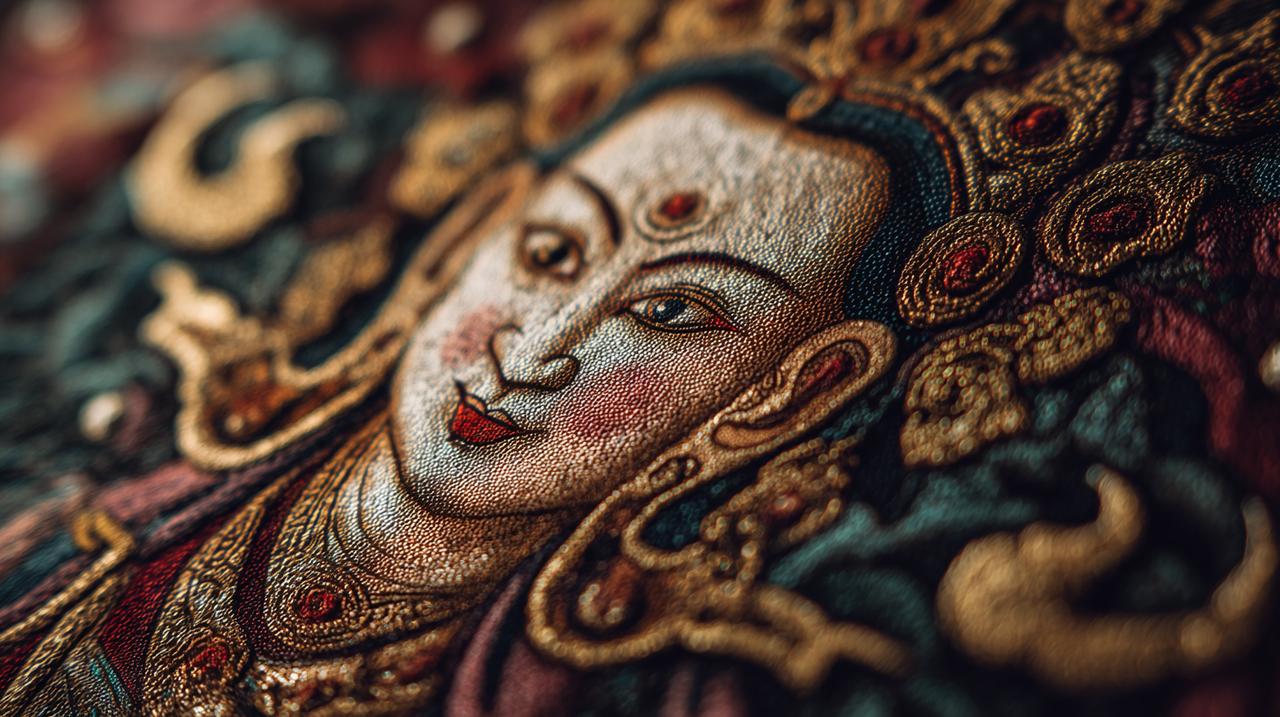
- Colors: These represent specific energies, elements, or aspects of the Buddha’s teachings. For example, blue often symbolizes wisdom, while white signifies purity.
- Deities: Each deity embodies a particular enlightened quality. Avalokiteshvara, for instance, represents compassion, Manjushri embodies wisdom, and Mahakala signifies protection.
- Mudras (Hand Gestures): These gestures convey specific meanings, such as teaching, fearlessness, or deep meditation.
- Mandala: A cosmic diagram, the mandala can represent the universe, a divine palace, or a state of mind. It serves as a powerful focal point for meditation and spiritual contemplation.
The Complex Craft of Traditional Thangka Painting
The creation of a traditional Thangka is an arduous journey, demanding not only immense skill and patience but also profound spiritual devotion. It is a meditative practice in itself, with each stroke imbued with deep intention. The process strictly adheres to ancient canons, often reflecting a cosmic order through precise measurements and symbolism. It typically involves several sacred stages, each vital to the final piece:
- Canvas Preparation: The cotton or linen cloth is meticulously stretched and primed, laying the foundational purity for the artwork.
- Drawing: A precise, sacred outline of the deity or scene is carefully drawn using charcoal or pencil. This is rigorously guided by ancient texts on proportion and sacred geometry.
- Coloring: Natural mineral pigments are applied layer by layer with exquisite precision, often using brushes crafted from animal hair, gradually building vibrant depth.
- Shading and Detailing: Artists add three-dimensional depth and intricate details, including subtle facial expressions, flowing garments, and elaborate ornaments.
- Outlining: All elements are re-outlined with fine black ink, sharply defining forms and enhancing their spiritual presence.
- Gold Application: Shimmering gold dust and delicate gold lines are applied, often burnished to a high sheen, signifying divine light and enlightenment.
- Eye Opening Ceremony: This is the final, most sacred step, where the eyes of the deity are painted. This symbolically activates the Thangka and invites the divine presence to reside within.
Having explored its origins and intricate creation, we now turn to the profound purpose of Thangka art: its indispensable role as a spiritual conduit and transformative tool.
The Unique Role of Thangka Art in Spiritual Practice
Beyond its undeniable artistic merit, Thangka art transcends mere aesthetics to serve as a profound “gateway to spiritual practice.” It offers a tangible link to the divine and acts as a powerful catalyst for inner transformation. Its rich iconography and deeply embedded spiritual intent make it an indispensable aid for practitioners seeking deeper insight and connection. But how exactly does it achieve this?
Case Study: How Thangka Guides Meditation and Focus
Imagine a practitioner, perhaps in a quiet meditation room, facing a beautifully rendered Thangka of Green Tara. As they begin their practice of deity yoga, central to Tibetan Buddhism, their gaze softly rests upon the Thangka. For hours, they might contemplate the deity’s compassionate expression, the vibrant hues of her robes, and the intricate details of her mudras, slowly internalizing every symbolic attribute. This deep visual absorption is not passive; it actively aids in developing profound concentration, helping to quiet the incessant chatter of the mind. As the practitioner aligns their focus, they begin to cultivate the specific qualities embodied by the deity—be it compassion, wisdom, or fearlessness. The Thangka acts as a vivid visual blueprint for this inner journey, guiding the mind to remain stable and focused. This transforms mere observation into a profound “traditional Thangka for meditation” experience. This process, remarkably, parallels modern psychological principles of visualization and intentional focus, demonstrating Thangka’s timeless efficacy.
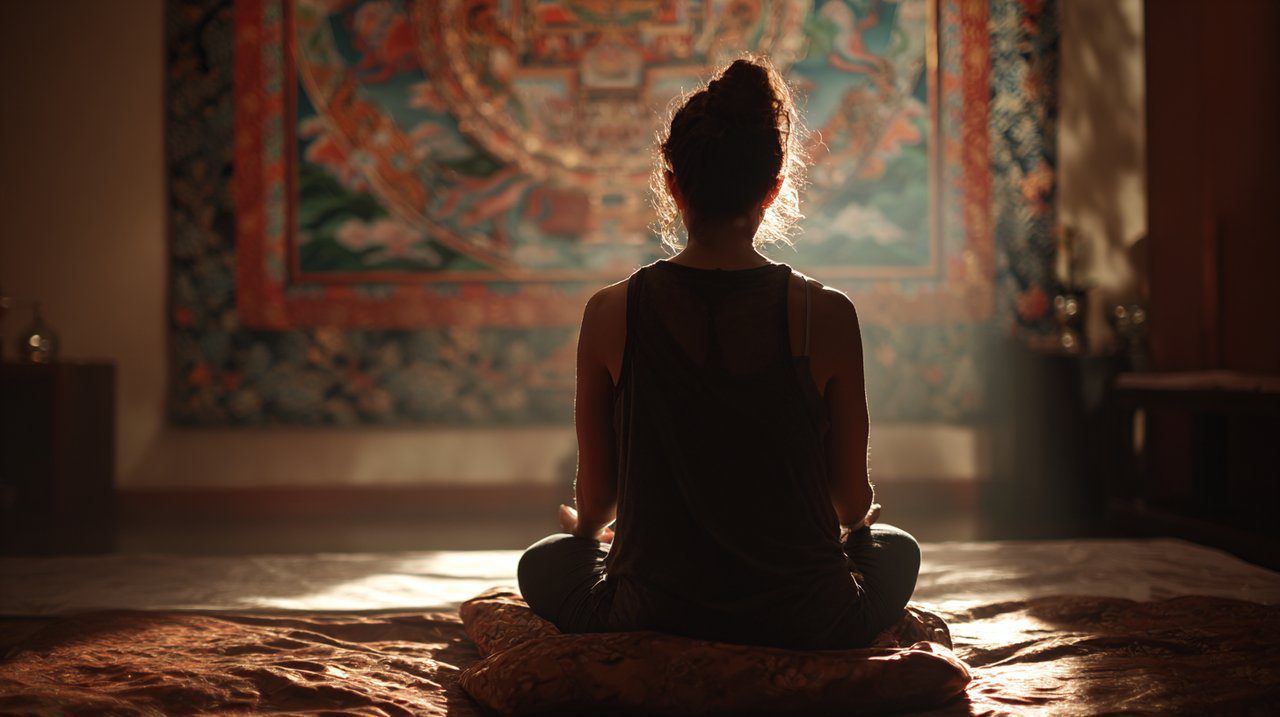
Buddhist Thangka Painting Significance: Deities and Symbols as Spiritual Guides
The profound “Buddhist Thangka painting significance” lies in its unparalleled ability to embody and transmit timeless spiritual truths. Each deity depicted is far more than a mere image; it is a vibrant representation of an aspect of enlightenment, a quality the practitioner can actively cultivate within themselves. For instance, a Thangka of Green Tara symbolizes swift, compassionate action, inviting the viewer to embody kindness and responsiveness. Conversely, a Thangka of Vajrapani represents powerful, unwavering resolve, inspiring inner strength. By contemplatively engaging with these sacred images, practitioners can invoke and integrate these profound qualities into their own being. Mandalas, often central to Thangka art, serve as intricate cosmic diagrams—sacred spaces that not only purify the mind but also invite deeper contemplation of the universe’s structure and the intricate path to awakening. How might these powerful symbols resonate with your own spiritual aspirations and guide your path?
Thangka Art in Different Tibetan Buddhist Lineages
Thangka art is integral to all major schools of Tibetan Buddhism, including the Gelug, Sakya, Kagyu, and Nyingma traditions. These lineages are central to the profound Vajrayana Buddhism teachings, which utilize a rich array of ritual objects, visualizations, and practices to accelerate the path to enlightenment. While the core purpose of Thangka as a spiritual aid remains consistent across these lineages, subtle yet significant variations exist. These distinctions might manifest in stylistic representations, the specific emphasis on certain deities, or the unique visual narratives depicted, each reflecting the profound teachings and focus of its respective lineage. For example, some lineages might favor a more austere style, while others embrace vibrant complexity. Regardless of the specific school, the Thangka consistently remains a revered object, deeply integrated into rituals, initiations, and daily personal practice. With a deeper understanding of Thangka’s spiritual significance, the next step is to explore how to practically integrate this ancient art form into your personal spiritual journey.
How to Deepen Your Spiritual Journey Through Thangka Art
Integrating “Thangka art for spiritual practice” can profoundly enrich your inner life, offering a unique avenue for growth and insight. Whether you are a seasoned meditator or just beginning your spiritual exploration, a Thangka can serve as a constant source of inspiration and a powerful focal point for your practice.
Choosing a Thangka: A Guide for Spiritual Connection
Selecting a Thangka is a deeply personal and significant decision, akin to choosing a spiritual companion. Consider these crucial aspects to ensure your choice truly resonates with your path:
- Authenticity: Prioritize a Thangka painted by a trained and consecrated artist. This ensures it rigorously adheres to traditional iconographic standards and carries genuine spiritual integrity.
- Iconography: Diligently research the deities or symbols that most profoundly resonate with your spiritual aspirations. Are you seeking wisdom, boundless compassion, steadfast protection, or profound inner peace?
- Quality: Carefully observe the precision of the lines, the vibrancy and depth of the colors, and the overall artistry. A high-quality Thangka is a direct reflection of the artist’s immense skill and devotion.
- Intention & Resonance: Most importantly, choose a Thangka that genuinely evokes a profound sense of peace, inspiration, or a powerful spiritual connection within you. Let your intuition guide this sacred choice, as it’s about finding what speaks to your soul.
Integrating Thangka into Daily Meditation Practices
Once you have chosen a Thangka that resonates with you, you can begin to incorporate it into your daily spiritual routine. Here are practical steps to effectively use a “traditional Thangka for meditation” and deepen your practice:
- Mindful Placement: Hang your Thangka in a clean, quiet, and dedicated space where you meditate or engage in contemplation. Ideally, position it at eye level to facilitate comfortable gazing.
- Sacred Purification: Before beginning your practice, you may choose to offer a small prayer or light incense to purify the space. This symbolically clears the environment and sets a clear intention for your session.
- Gazing (Shamatha): Begin your meditation by simply gazing at the Thangka. Allow your eyes to gently absorb its intricate details without judgment. Notice the vibrant colors, the precise forms, and the profound expressions. This initial focus profoundly aids in stabilizing and quieting the mind.
- Visualization (Vipassana): As your mind settles and concentration deepens, you can begin to visualize the deity or scene from the Thangka in your mind’s eye. Imagine its luminous presence, its inherent qualities, and allow these virtues to permeate your entire being.
- Mantra Recitation: If appropriate for the specific deity depicted, you can recite its associated mantra while holding the sacred image vividly in your mind. This combines visual and auditory focus for a holistic practice, and understanding the mantra chanting benefits can further enrich this experience, promoting profound states of calm and spiritual connection.
Five Ways Thangka Aids Spiritual Practice
Beyond specific meditation techniques, Thangka art profoundly enhances your spiritual journey in several key ways:
- Enhanced Focus and Concentration: The intricate details and precise iconography of a Thangka provide an exceptionally stable and compelling focal point for concentration, effectively quieting discursive thoughts and training the mind.
- Cultivation of Virtues: Contemplating deities that embody virtues like boundless compassion, profound wisdom, or unwavering fearlessness directly helps to cultivate and awaken these very qualities within oneself, directly influencing one’s spiritual trajectory and understanding of karma and rebirth concepts.
- Intuitive Symbolic Communication: Thangkas function as profound visual textbooks, conveying complex Buddhist philosophical concepts, intricate narratives, and esoteric teachings in an accessible, intuitive, and deeply impactful manner.
- Connection to Spiritual Lineage: Engaging with a Thangka evokes a powerful sense of connection to the vast and unbroken lineage of practitioners and enlightened masters who have utilized these very tools for their spiritual growth over centuries.
- Creation of Sacred Space: The mere presence of a Thangka instantly transforms any environment into a more sacred and consecrated space, making it inherently conducive to deep meditation, heartfelt prayer, and profound introspection.
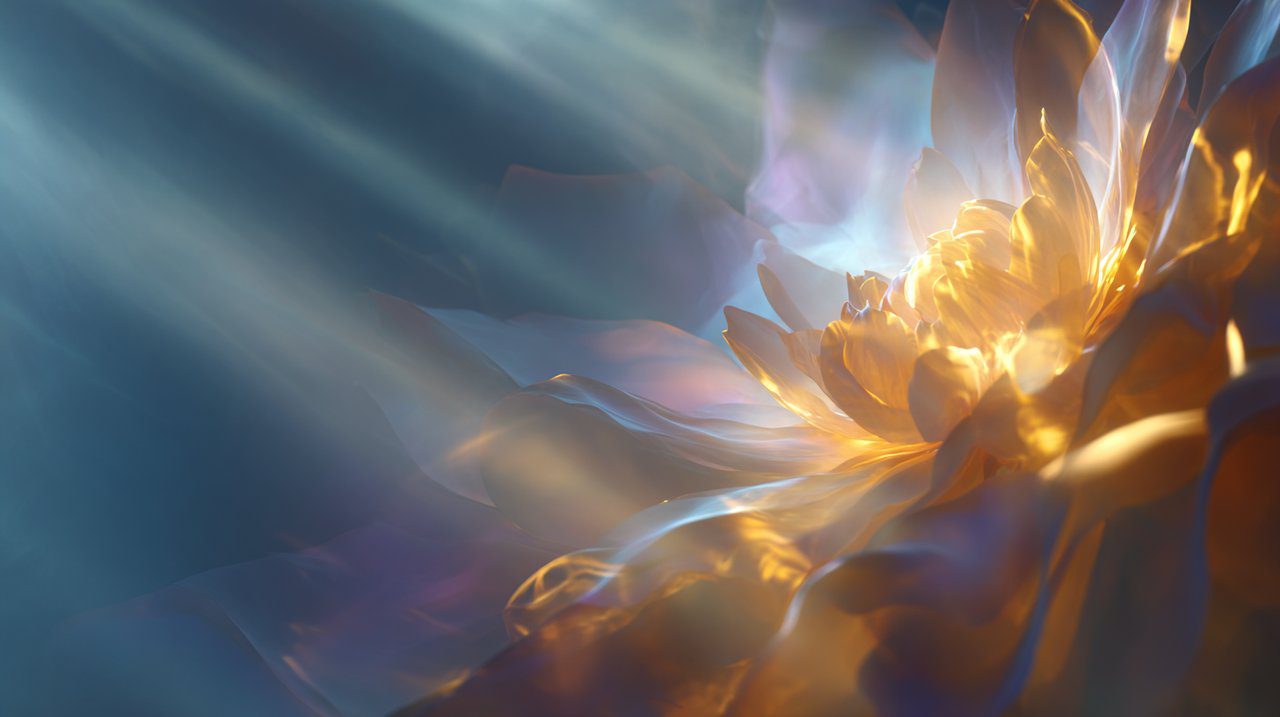
Thangka art is undeniably a living tradition, a vibrant and enduring bridge between the sacred and the mundane. It offers a profound and accessible path to spiritual awakening, inviting us to look beyond the superficial and delve into the boundless wisdom that resides within.
As a visual compendium of enlightenment, a Thangka is not just seen; it is experienced, guiding the practitioner towards inner clarity and compassionate action.
Understanding how to thoughtfully choose and effectively utilize a Thangka can significantly deepen and enrich your personal spiritual practice. The true wisdom of Thangka lies not just in its beauty, but in its capacity to serve as a constant guide and source of inspiration on your unique spiritual path.
💡 Frequently Asked Questions
Thangka art is a Tibetan Buddhist scroll painting, typically depicting a Buddhist deity, scene, or mandala. It is a profound spiritual discipline and a visual compendium of Buddhist philosophy, designed to be rolled up for portability.
Thangka art serves as a 'Gateway To Spiritual Practice,' providing a tangible link to the divine and a powerful tool for inner transformation. It aids practitioners in meditation, helps cultivate qualities like compassion and wisdom, communicates complex Buddhist teachings, and creates a sacred space.
Traditional Thangkas are painted on cotton or linen canvas using natural mineral and organic pigments (e.g., lapis lazuli for blue, cinnabar for red), often mixed with animal glue, with gold and silver used for highlights. The creation is an arduous multi-stage process including canvas preparation, precise drawing, meticulous coloring, shading, outlining, gold application, and a final 'Eye Opening Ceremony' that symbolically brings the Thangka to life.
To integrate Thangka art, choose a piece that resonates with your spiritual aspirations and place it in a clean, quiet meditation space. Practices include gazing at the Thangka to stabilize the mind (Shamatha), visualizing the deity's qualities (Vipassana), and reciting associated mantras while focusing on the image. It helps enhance focus, cultivate positive emotions, and connect to Buddhist teachings.

